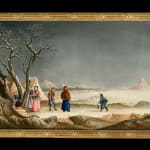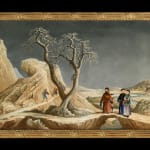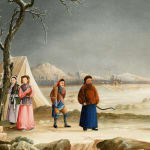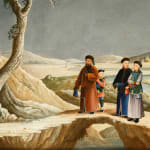A RARE PAIR OF EARLY 19TH CENTURY CHINESE EXPORT OIL PAINTINGS, ATTRIBUTED TO FATQUA
W: 66cm / 26”
Further images
Provenance
Private Collection: Paris, France since 1955.Literature
Compare:
Painting of a winter scene, on mirror glass, V&A Museum, London (P. 11 - 1936), illus. R. Soame Jenyns, Chinese Art, 2nd ed. (Oxford, 1981), fig. 70
Winter hunting scene, oil on canvas, The Collection of Patricia Kluge, Sotheby’s, New York, 8-9 June 2010, lot 16
See also the collections of the Peabody Essex Museum, Salem, Massachusetts and the Hong Kong Museum of Art for trade paintings in the Fatqua style and for examples comparable in composition
Publications
Crossman, Carl L. The China Trade: Export Paintings, Furniture, Silver & Other Objects. Antique Collectors’ Club, 1972.
Conner, Patrick. Paintings of the China Coast: The Mariner’s Museum. Antique Collectors’ Club, 1984.
Conner, Patrick. Hong Kong, Shanghai, and Canton: China Trade Paintings in the Victoria and Albert Museum. V&A Publishing, 1986.
Van Dyke, Paul A. The Canton Trade: Life and Enterprise on the China Coast, 1700–1845. Hong Kong University Press, 2005.
An exceptional and rare pair of early 19th-century Chinese export oil paintings, depicting Manchu winter hunting scenes, retaining their original giltwood frames. Attributed to Fatqua.
Chinese Export: Circa 1800
This rare and finely executed pair of Chinese export oil paintings, depicting winter hunting scenes, can be attributed to Fatqua, one of the most accomplished Cantonese artists of the early nineteenth century. Celebrated for his mastery of Western painting techniques and his refined treatment of Chinese subject matter, Fatqua was admired for blending European artistic conventions with traditional Chinese themes, producing works highly prized by Western collectors.
In the first painting, a nobleman and his retinue stand in the foreground, their richly attired figures contrasted against a rugged mountain path along which hunters advance, armed with spears and accompanied by attendants. The inclusion of a young boy and female figures suggests the hunt was as much a social occasion as a test of skill.
The second painting depicts a similar gathering near a hunting encampment, with tents pitched beneath frost-covered trees. A returning hunter crosses the frozen terrain, game birds in hand and bow slung over his shoulder, while in the distance, imperial-style pavilions and banners evoke the grandeur of a Manchu elite winter hunt; a practice rooted in nomadic heritage and military tradition.
Fatqua’s distinctive style is evident in the fine detail of the faces, the subtle modelling of forms, and the luxuriant depiction of winter garments. Robes are shaded with delicate gradations and fluid folds, reflecting the artist’s adoption of Western chiaroscuro while preserving the elegance of Chinese line and pattern. The barren trees, jagged rocks, and snow-covered tracks are painted with precision, evoking the season’s austere beauty. His landscapes employ a deft combination of European linear perspective and traditional Chinese spatial organisation, creating depth without losing the lyrical quality of Chinese landscape painting.
Winter hunting is a rare theme in Chinese export painting, yet one that is rich in atmosphere and cultural resonance. The portrayal of aristocratic figures within meticulously detailed landscapes would have held strong appeal for Western collectors captivated by the rituals and pageantry of the Qing elite.
Both paintings retain their original carved and giltwood frames, a rare survival that not only enriches their visual appeal but also underscores their exceptional state of preservation and overall condition.
Fatqua’s paintings are represented in major collections worldwide, including the Peabody Essex Museum, the Hong Kong Museum of Art, and the Victoria and Albert Museum. Comparable compositions with landscape narratives attributed to the artist reinforce this attribution.
The combination of rare subject matter, exceptional execution, original framing, and the harmonious integration of Chinese and European artistic traditions marks this pair as outstanding examples of early nineteenth-century China Trade art.









